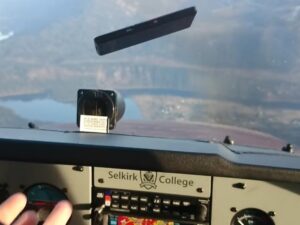It’s been exactly seven years since I last wrote something I was passionate about. What an awfully long time to go without some sort of record for reflection and growth. This collection of pages, acting as a virtual time capsule, has me reminiscing about the adventures and experiences I’ve had. Looking back at it makes me wish that I had kept sharing some of these experiences. It’s hard to imagine that so much time has passed since my last post, but there it is.
I think that on some level, the sorts of topics I was interested in so many years ago are much the same as what I am passionate about today. If anything has changed, it’s that I feel I have gained clarity or focus when it comes to what I define myself by and what I find fascinating. Thinking about it another way, a whole lot has changed in my eighty-four-month absence. I went from an aviation student to a commercial pilot flying as the first officer on some beautiful corporate-style jets, to a change in pace working at a regional airline, followed by a departure from the aviation world, and starting again as a university student. This time I’m following a path that many thought I would originally follow. A path that took me days, weeks, and many exhausting months of thought to fully figure out. I decided I would become an engineer, specifically, a computer engineer.
There were many reasons why I left the aviation industry, but that doesn’t mean I didn’t enjoy the time I had there. I love to fly. I always have. There isn’t a feeling quite like it. Well, maybe it’s similar to the feeling you get when you’re going around a corner on a motorcycle, but that isn’t the point. There is no substitution for flight. Through my years of training and real-life work experience, I learned a tremendous amount about many different topics and skills.
Aviation has taught me the importance of collaboration, communicating and acting with precision, as well as the confidence required to be an effective decision-maker. These skills were developed through continuous training in day-to-day and simulated experiences, lectures, and countless hours of practice. Aside from these tangible skills, I also had opportunities to exchange thoughts and ideas with all sorts of people that I met along my travels. I think this is one of the things that I enjoyed most because every person has their own stories and experiences that many can learn from. It was through many of these conversations that I came to realize that family holds the highest value in my life.
When I graduated from college, I accepted an opportunity to work for a company that operated jets based out of Alberta. I started my career working through the night, one week on, one week off, calculating the total times pilots worked to ensure that Transport Canada’s regulations were respected regarding flight and duty. Alongside this, my other responsibilities were to ensure aircraft were clean and sorted for the next day, and to fulfill any requirements for the client’s flight. The shifts were long, but I thoroughly enjoyed them. I loved having a consistent routine, and I loved completing tasks my way and in my own order through the night. A couple of months into this, I realized that if I could automate the regulation tracking process, then I could accomplish much more elsewhere with the added benefit of the increase in report accuracy.
The software that I developed was relatively simple. It was based around the idea of an advanced macro that was able to send keystrokes based on predicted software states and image comparison against a reference set. The program accomplished this through the implementation of a custom scripting language. This allowed for the addition of new routines and the ability to modify old ones to adapt to client updates. I initially planned for it to cycle through the handles of each control interface, but unfortunately, the software I was trying to automate operated by sending only images of the interface from a remote machine. This meant that the handles to the interface did not exist locally, and I could not directly access them. When I had finished developing this software, the time needed to complete the reports was reduced from around two hours to about twenty minutes. The best part about these reduced times was that I could complete other tasks while the computer did the calculations because it was fully automated. With this accomplishment under my belt, I was reminded how much I loved solving puzzles like this and how I had forgotten about this passion that I had once explored so frequently.
After a year of working through the perpetual darkness of night shifts, I progressed to the position I had trained at college for, a commercial pilot. What an absolute blast that was! Going from a single-engine piston aircraft with a cruise speed of around 120kts, to a multi-engine turbine aircraft cruising around Mach 0.72 was literally quite the change in pace, and I loved every moment of it. The Cessna Citation CJ2+ is a ton of fun to fly. It felt like a Skyhawk if it was designed as a formula one car.
I flew all over North America, specifically three countries, eighty-nine unique destinations, and 260 legs, seeing what life was like away from my own home, meeting new people, finding new adventures. All this travel was thrilling, to say the least, but I was longing for a stronger connection with my family. I was tired of missing the weekends with friends, the birthdays at the grandparents, the Christmases with my family. I was in luck, though! Seven months after starting my time on the CJ2+, I was offered a position on the company’s newest aircraft with the condition that I moved back to the Toronto area at the end of summer. The timing couldn’t be more perfect! With the excitement that things were working out for the better, I was remotivated to push through the long workdays and enjoy my very last Albertan summer.
A few weeks later, on one April evening, I was called out to replace a fellow first officer on a flight returning to Calgary [CYYC] and fly the aircraft to Kelowna [CYLW] for the night. I always enjoyed flying into Kelowna because of its geographical similarities to Castlegar [CYCG], where I trained. I loved the mountains, and I loved the cities and towns that reside between them. I also really loved the approaches into Kelowna. They were always a lot of fun because of the steeper descents required and the added challenges that come with them. Lastly, I loved visiting Kelowna because I had some friends who lived there who were always welcoming to my visits, and it was nice to get away from the repetitive hotel lifestyle.
It was on this chilly April evening that I began down a path that I would never wish to leave. It started when I called up a close friend to ask if she wanted to catch up over dinner. As it turned out, she had already made plans with another friend of hers and was excited to have both of us there. At dinner, it quickly became apparent that this new acquaintance was an extraordinary person. To summarize a long story, we hit it off and started dating soon after. I was over the moon!

A few months go by, July has just started, and I’ve completed my month-long training course in Missouri, certifying me to perform as first-officer on the Embraer Legacy 450/550. If the Citation was an F1 car, the Legacy was a rocket ship. Flying at Mach 0.83 at 45,000ft made travelling to distant locations a breeze. From Honolulu [PHNL] to Calgary [CYYC] in just under six hours or from Barbados [TBPB] to Toronto [CYYZ] in four hours, forty-two minutes. The Legacy really was an aircraft that would bring a smile to any pilot’s face. To repeat myself, I loved every bit of these flights; all five countries, 413 legs, and sixty-seven unique destinations. I loved exploring these new stops on my sometimes short layovers. I loved planning my descent and “greasing” the perfect landing on the runway of my destination. I loved seeing the little kids standing by the small-airport fence, watching as I performed a roaring takeoff over their small rural town. I absolutely loved all of this. What I didn’t love was that my work schedule isolated me from all the little day-to-day things that most people would probably take for granted.
With this specific career path, I was always on-call and had to be ready on a moment’s notice to travel to the airport and head out to wherever needed. While this wasn’t an issue most of the time, the erratic frequency at which my schedule was changed on me throughout the day really burned me out. Funnily enough, I wrote a program that monitored pilot schedules and updated the crew about any changes, sometimes hours before dispatch. Another problem solved! Well, another bandage over the spreading wound. With each literal and figurative last-minute change to my schedule, a crushing wave of exhaustion would rush over me. I knew I had to make a change, but I was unsure how, when, or where.
Twenty-two months after I started this journey on the Legacy, I decided that a change in operation would be the next logical step. “Don’t give up on what I had worked for all these years,” I told myself. The next step was to apply to the airlines and start at the bottom again. After submitting my resume and a quick interview process, I was hired! I was excited to leave behind all my issues and start fresh. I looked forward to bringing my experiences to the flight deck of another aircraft and gaining knowledge from the more experienced pilots that I would work with. Most of all, though, I was looking forward to the prospect of being home more frequently on a stable schedule with my fiancée (after I had put in my dues, of course).
Unfortunately for me, given the way the unionized company works, my name was drawn last out of the seniority hat, which meant that I was shipped back off to Vancouver with an aircraft that would likely never provide me with a path back to my home. I would have to commute between Toronto and Vancouver any time I had time off. Not fun! I understand that this method of drawing names from the hat is the fairest way out of all the poor options to determine seniority, and thus directly where you will work. Still, I’d be lying if I said I wasn’t disappointed that the pilots with less experience than me who live out in Vancouver claimed all the spots on the Toronto-based aircraft in the exceedingly more likely chance that they could move back to their home (which they did after a month). C’est la vie!
I tried my best to keep my head up through this new work environment, but I struggled with the poor work hours, abysmal pay, poor work culture, and comparatively dull routes. I realized that I was much less happy here than I was before and that my change in career paths exasperated all the issues I tried to fix. I knew that a more significant change was probably needed, but I knew I had to be sure before pulling the trigger.
Through the year that I worked at the regional airline, I would discuss with my coworkers who have been there for their entire careers about what their lives were like to paint a better picture of what my life would be like one day. I asked all sorts of senior captains and first officers what it was like to be there for so long if they were happy and enjoyed what they did and what they would do if money weren’t a factor. The sad thing is that the only people that said that they enjoyed what they did were all within a year or two of retiring. Every other person that I was able to talk to all would either beat around the bush and avoid admitting they were unhappy, or they tried to spin it in a positive way; usually by saying something along the lines of, “if I were home more, my wife would have divorced me long ago.” Cheerful stuff, eh? The conversation that hit me the hardest was when a captain told me how he suggested to his teenage son to start a career as a pilot. The son replied that he didn’t want to do to his family what his dad did to theirs, rejecting the entire concept.
Aviation is a harsh industry for so many reasons. The enormous expense of training and education puts this career path out of many students’ reach, the comparatively poor pay for a large portion of the career, and the poor schedules with a lot of time away from family are some of the most immediately prominent factors in my mind. I don’t regret getting into aviation. It changed me into who I am, and it connected me with my forever person. I just realized that when I was away, I was removed from the people I love and that I could not help whenever somebody was in trouble, or an important decision had to be immediately made. I remember when my partner and I’s beloved cat got sick, and I could not do anything about it. This sole experience immediately made me realize that I didn’t want to miss my family’s life. I wanted to be there for the good and bad times. I only have this lifetime to live, and I don’t see the benefit of spending most of my time away from the people I chose to spend that very life with. Not coming home at night, even if it’s only to say good morning or goodnight, was something I was tired of experiencing. That’s why I made the change that I did.
I’m currently finishing up my second year studying computer engineering, and I love every part of it. The courses that I’m enrolled in align with the interests that I explored through the years. My two favourite courses that I’ve completed so far are Digital Systems and Software Systems. The former focused on logic circuits and developing standard and integrated circuits using technologies like transistors, CPLSDs, and FPGAs, while the latter explored the software development cycle with a focus on object-oriented programming languages. This alignment of interests excites me for what I will continue to study for the next few years.
Making the switch from a full-time career to the life of a STEM student hasn’t been easy in any sense of the word, but I’m honestly grateful that I made the switch when I had. With the added shutdowns of the COVID-19 pandemic, my timing couldn’t have been better. I’m glad that I got to experience what I did when I did. I’m also glad that I followed the aviation career path first because I think sometimes we all get caught up in the search for which side of the hill has the greener grass. Thinking about how little I knew about careers, the world, and my future goals, I feel that if I had picked an unknown third option to study, then possibly I’d be dreaming about what it would have been like above the clouds, not knowing what I know now about the aviation industry.


